The Salkantay trek is a high altitude 74km/46 miles hike in the Cusco region, Peru. The route starts at Mollepata, a small town 100km from Cusco. It takes you through some incredible nature areas of the Andes with breathtaking scenery and amazing wildlife. Trekking includes a visit to two Inca sites; Llactapata and Machu Picchu both history and nature lovers will enjoy the Salkantay trek.
Salkantay is considered to be a cheaper alternative to the famous Inca trail though it goes through completely different areas and unlike the Inca trail Salkantay finishes in Aguas Calientes (from where you walk to MP) not at Machu Picchu itself. Nowadays Salkantay is one of the most popular treks in Peru.

Table of Contents
Salkantay trek overview
- Total distance – 74km/46 miles
- Required number of days – 5 days
- Starting point – Mollepata
- Finishing point – Aguas Calientes
- Average altitude – 3000m
- Highest point – Apacheta or Salkantay Pass, 4580m
- Permits – no special permits are needed, the trek can be done independently or with a guide.
If you’d like to do more treks around Cusco check our posts on the other two incredible trekking routes the Ausangate trek and the Choquequirao trek.
If you’re thinking about exploring more of Peru there are several great small group tour options to join;
- Salkantay Trek & Machu Picchu (G-Adventures)
- Inca Explorer (G-Adventures)
- Peru Multisport (G-Adventures)
Best time for trekking
There are two seasons in the Cusco region; the dry season and the rainy season. The dry season is from April to October, the driest months June to August – very little rain, lower temperatures, especially at night time. July – August is the peak tourist season expect prices to be higher and the sights are busier.
The rainy season is from November to March, with the most rain falling between December and February. During this period temperatures are higher, it’s very humid, rains a lot, not many tourists. December – February is the worst time for hiking in Cusco.
Practical information for the trek
The Salkantay trek is a high altitude route, good acclimatization is essential.
Drink enough water – hydration is very important for this hike.
There are many streams and rivers on the way but we’d recommend using water purification tablets or a life-straw bottle due to many alpacas walking around local water is not safe for drinking.
On the first and second day of the trek you gain altitude quite fast don’t push yourself too hard if you feel tired; stop, rest, drink water.
There are a couple of steep descends on the trek hiking poles will be quite handy they will take away some pressure from your knees.
From the third day on there will be villages on the way where you can get cooked meals or buy some food e.g. pasta, tuna, instant soup, snacks, cool drinks, etc.
How we rank Salkantay
- Difficulty level – 4 out of 5; the first two days are quite demanding; high altitude and steep ascents, other days are easier.
- Scenery – 5 out of 5; Humantay and Salkantay lake and glacier were the highlights.
- Touristy – 3,5 out of 5; quite busy compare to Choquequirao or Ausangate treks but not as busy as the Inca Trail.
For those who like the outdoors South America is a real paradise there are many adventurous things to do here and hiking is one of them. The region offers a great variety of hiking trails such as the O Circuit in Torres del Paine, hikes in El Chalten, or a trek to Mount Roraima.
Travel insurance for the trek
Like any outdoor activities trekking involves risks of getting injured, losing or breaking gear, cancellation of the trip due to unpredictable weather conditions (e.g. landslides after the rainy season, etc.). Salkantay is a high altitude trek through remote areas of the Peruvian Andes it’s highly recommended to have travel insurance that will cover you for the period of the hike.
Choosing an insurance company that you can rely on in case of emergency is very important that’s why we recommend World Nomads. They focus on covering outdoor activities including high altitude hiking. Peru is one of their top hiking destinations which means they have experience in working with local companies. Another great thing about World Nomads is that you can buy insurance online while traveling, it takes only 2 minutes. Their insurance policy is very flexible you can purchase one that covers the whole trip or only the hiking part of it, even if it’s one or two days. Get a quote right now!
Note! Always read carefully terms and conditions.
Packing list for the trek
If you decide to hike without a guide you’ll need camping gear; tent, mattress, camping stove, gas, pots, etc. If Salkantay is the only trek you’re going to do rather rent camping gear than bring your own from home if you’re planning to do a couple of hikes – having your own stuff is better.
Backpack with rain cover – even if you hike in dry season use a rain cover to protect your backpack and the stuff inside from dust and humidity. If you hike independently you’ll need a good and comfortable 60L backpack to be able to fit all the gear and attach a tent. If you do it with a company you’ll need only a day pack your stuff will be carried by horses or driven by car in big dry bags.
Tent – you camp 3 nights on the trek. It’s important to have a good reliable tent that won’t fail in case of rain, strong wind or snow. We became big fans of MSR tents, they’re not the cheapest but one of the best especially for hiking and long term traveling; light, strong, pack small, easy to pitch – perfectly designed for adventure in the mountains.
Sleeping bag – make sure your bag can go down to 0°C/30°F for summer and to -5°C/20°F for winter. It gets very cold up in the mountains at night. Down bag vs synthetic bag – both have their advantages and disadvantages; for the dry cold season a down sleeping bag will work great; it packs small, light and warm the main problem is if it gets wet but in dry season chances of rain are quite small. For wet season synthetic bag will be better; it dries quick, some modern bags are quite small and light as well.
Mattress – we have inflatable camping mats; light and small – fit in a backpack, soft, comfortable, good isolation. After we tried them once we decided not to use foam mattresses again.
More details on what to pack for trekking you can find in our Peru packing list post.
Download our free Salkantay trek packing list.
Salkantay trek cost
Independent trek, per person
Transport – 30 Sol/US$10 bus Cusco – Mollepata, bus Hidroelectrica – Cusco – 60 Sol/US$18; train Aguas Calientes – Hidroeléctrica (optional, you can walk) – 60 Sol/US$19 one way.
Shopping (food, gas) – 100 Sol/US$30.
Entrance fee – Machu Picchu 152 Sol/US$45, if you want to go up to Machu Picchu or Huayna Picchu mountain – 200 Sol/US$59. Make sure to buy your entrance tickets beforehand, especially if you travel in peak season and want to go up one of the mountains.
It’s impossible to pay for the entrance at the ruins, you can book tickets through the official website it takes time and involves several steps. Another option is to do instant booking through GetYourGuide (the easiest and fastest but more expensive way); Machu Picchu, MP + Machu Picchu Mountain, MP + Huayna Picchu Mountain.
Accommodation – 3 nights camping – between 10-30 Sol/US$3-10 (there are free campsites with limited facilities and private campsites/locals’ houses where you pay about 10 Sol/US$3 per tent). One night in a hotel in Aguas Calientes – from 26 Sol/US$8 pp in a hostel.
Gear rental (optional) – depending on what you rent prepare to pay between 160 Sol/US$50 and 260 Sol/US$80.
Total; 400 Sol/US$120 (420 Sol/US$125 with Machu Picchu or Huayna Picchu mountain) + gear rental and train tickets.
With a tour, per person
It’s easier to go with a tour and more expensive as well. Tours start from US$400 per person and usually include; accommodation (camping and one night in a hotel in Aguas Calientes), transportation (except train tickets), entrance fee, food, water, tents and mattresses, porters, chef, and a guide. Tours and prices vary from company to company some are more luxurious with better food, nicer accommodation, some are more basic where you pay extra for everything.
More details on how much to budget for traveling around Peru you can find in our South America travel cost post.
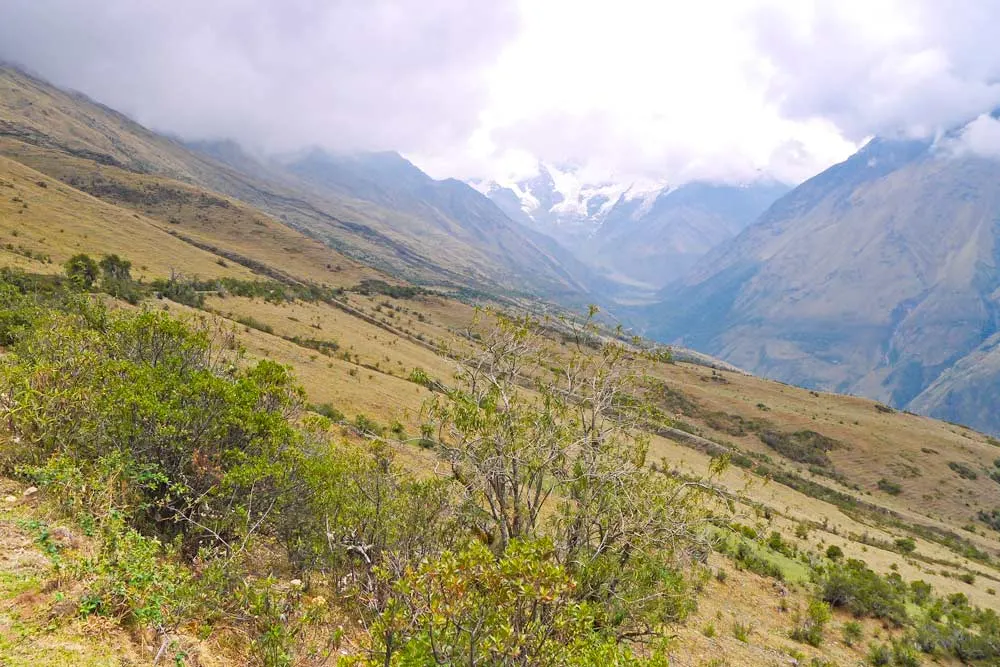
Guided tour vs independent trek
Independent trek
Pros
- As you can see in the cost section it’s much cheaper, especially if you’re two or more people – you’ll save a lot of money.
- You’re free to choose when to stop and where to stay if you don’t like a place you always can go to a different one; if you feel tired you can stop earlier etc.
- It’s always an adventure to plan and prepare for a hike.
Cons
- It’s more challenging; you carry all your stuff, you pitch a tent, cook, basically do everything on your own.
- There is no pack up if you forget or lose something you’ll have to handle it all by yourself.
- If you’re alone it might be lonely to wander around the mountains.
Guided tour
Our advice when you book a tour make sure what is included and what is extra and double check that your Machu Picchu tickets are for the right day and time and include Machu Picchu or Huayna Picchu mountain if you’re planning to go up one of them. We met some disappointed travelers whose tickets, booked through an agency, were no right.
Pros
- It’s easy all you have to do is to find a good reliable company and they’ll arrange everything for you, no planning, last minute shopping, finding a bus etc.
- You don’t carry your stuff, you don’t cook or set a campsite – all you do is walking.
- It might be fun is you get a fun group of people and a nice guide.
Cons
- It’s much more expensive.
- It takes away some part of the adventure.
Salkantay trek distances
- Cusco – Mollepata – 100km/62mi., bus
- Mollepata – Soraypampa – 22km/13,6mi., long ascend, +1000m
- Soraypampa – Chaullay – 21km/13mi., first long ascend to Apacheta pass, +750m; then long descend to the campsite, -1500m
- Chaullay – Lucmabamba – 18km/11mi., descend, – 800m
- Lucmabamba – Llactapata – 7km/4,3mi., steep ascend to the ruins, +900m
- Llactapata – Aguas Calientes – 13km/8mi., long descend, – 1000m.
Stops on the route
Mollepata (2900m)
A small town where you can get by bus, the beginning of Salkantay trek.
- Campsite – no
- Hotel – yes
- Shop – yes
- Cooked meal – yes
- Tap with running water – yes
- Toilet – yes
- Shower – yes
Soraypampa (3900m)
A first night stop, not a town just an established camping area.
- Campsite – yes, one free and two private sites for 10 So/US$3 per tent.
- Hotel – yes, before the campsites.
- Shop – yes, at the first campsite on the way.
- Cooked meal – yes, at the hotel
- Tap with running water – yes
- Toilet – yes, at paid campsites
- Shower – yes, at paid campsites.
Huayracmachay (3750m)
- Campsite – yes, one free, one for 10 Sol/US$3 per tent
- Hotel – no
- Shop – no
- Cooked meal – no
- Tap with running water – yes, at a paid campsite
- Toilet – yes, at a paid campsite
- Shower – yes, at a paid campsite
Chaullay or Chayway (2900m)
- Campsite – yes, 10 Sol/US$3 per tent
- Hotel – yes
- Shop – yes
- Cooked meal – yes
- Tap with running water – yes
- Toilet – yes
- Shower – yes
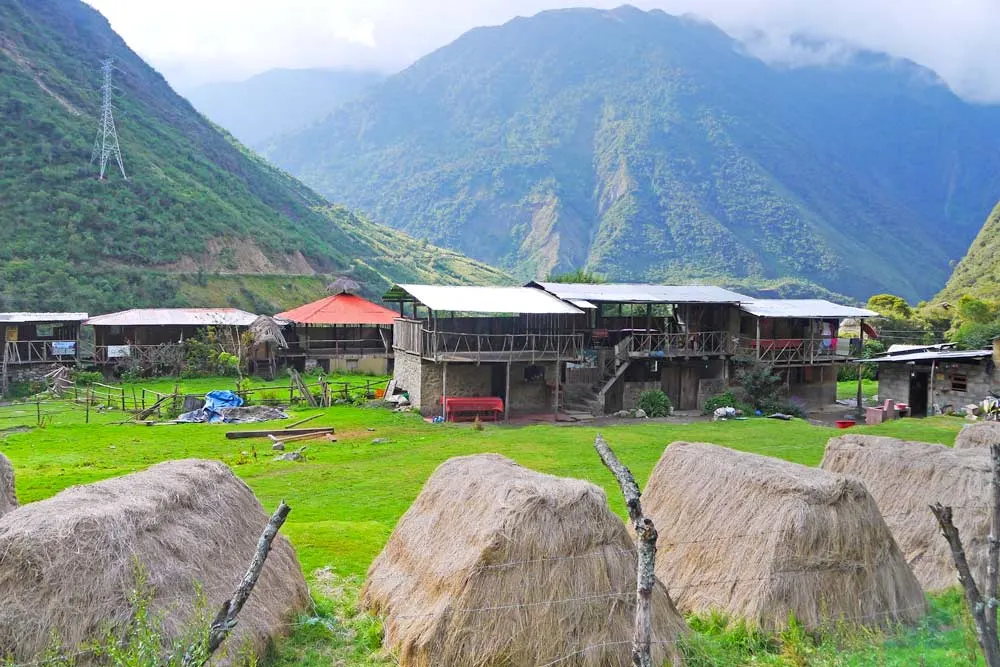
Collpapampa or Colpapampa (2800m)
- Campsite – yes, 10 Sol/US$3 per tent
- Hotel – no
- Shop – yes
- Cooked meal – yes
- Tap with running water – yes
- Toilet – yes
- Shower – yes
La Playa (2000m)
- Campsite – yes, 10 Sol/US$3 per tent
- Hotel – no
- Shop – yes
- Cooked meal – yes
- Tap with running water – yes
- Toilet – yes
- Shower – yes
Lucmabamba (2100m)
A small village with coffee plantations and beautiful views.
- Campsite – yes, 5-10 Sol/US$3 per tent
- Hotel – yes
- Shop – yes
- Cooked meal – yes
- Tap with running water – yes
- Toilet – yes
- Shower – yes
Santa Teresa (1800m)
Quite q touristy place, many people come here to visit nearby hot springs.
- Campsite – yes, 10 Sol/US$3 per tent
- Hotel – yes
- Shop – yes
- Cooked meal – yes
- Tap with running water – yes
- Toilet – yes
- Shower – yes
Hidroeléctrica (2000m)
Nobody usually stays here, it’s only 2 hours walk to Aguas Calientes.
- Campsite – no
- Hotel – yes
- Shop – yes
- Cooked meal – yes
- Tap with running water – yes
- Toilet – yes
- Shower – yes
Accommodation in Cusco
- Budget | Blacky Hostel | The New Paradise Cusco | Xplora Hostel Cusco |
- Middle price | Hotel Chavin Imperio del Sol | Yanuy Culinary Guest House | Hotel San Pedro Plaza |
- Luxury | Garden of San Blas | JW Marriott El Convento Cusco | Palacio del Inka, A Luxury Collection Hotel |
Getting from Cusco to Salkantay (Mollepata)
The trek starts at Mollepata, a small town 100km from Cusco.
The first morning bus to Mollepata leaves at 4 am (there are several buses during the day) from the Arcopata bus terminal, a small terminal at Arcopata street, the journey takes 3 hours. We’d recommend going to the terminal the day before to make sure where it is and what time the bus leaves. Price 30 Sol/US$10.
Once in Mollepata you can start walking (as we did) or take a local truck that will get you to Sayapata from where you can start walking to Soraypampa, the first-night campsite, about 2-3 hours walk. Price about 100 Sol/US$30 per car.
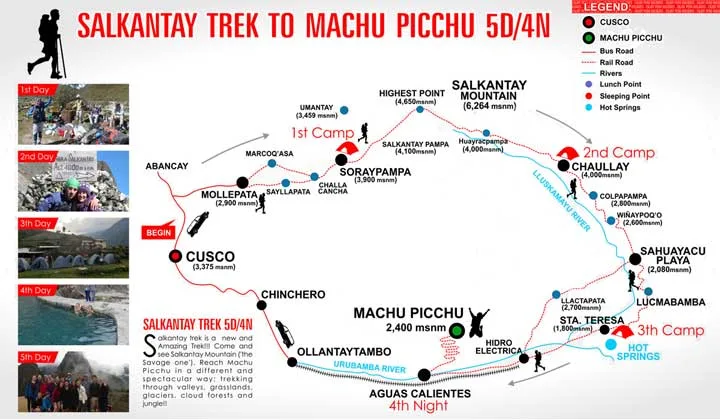
Salkantay trek – a 5-day itinerary
Day 1. Bus Cusco – Mollepata, 100km. Mollepata – Soraypampa, 22km
Cusco (3400m) – bus to Mollepata (2900m) – Soraypampa (3900m), 22km/13,6 miles
If you want to walk all the way to Soraypampa we’d recommend to start the day early and take a morning bus from Cusco. The journey to Mollepata takes between 2,5-3 hours.
From Mollepata many people take a taxi/truck to Soraypampa or a couple of kilometers before; it makes the first day shorter, you get to the campsite in a couple of hours instead of walking for 6-7 hours. We walked this part and unlike some people say the walk wasn’t unpleasant or along the road, in fact, the walking trek and the road split. It’s a bit difficult to find the trail in Mollepata, ask around or follow a group if there is one.
The main reason we decided to walk is to give our bodies more time to acclimatize (it was our first hike in Cusco), the altitude difference between Mollepata and Soraypampa is 1000m if you get by car you gain it very fast, walking gives you more time to adjust.
Highlights
- Humantay lake and glacier (4200m) – quite a steep uphill walk from Soraypampa campsite, +300m. It was one of the most beautiful lakes we’ve ever seen, the colors are just incredible!
Challenges
- Finding the trail in Mollepata
- A steep ascent from Mollepata to Soraypampa, 1000m up
- Sleeping at high altitude, 3900m

Day 2. Soraypampa – Chaullay, 21km
Soraypampa (2900m) – Apacheta/Salkantay Pass (4580m) – Huayracmachay (3750m) – Chaullay (2900m), 21km/13 miles.
This is the toughest day of the hike; high altitude, going up to 1500m to Apacheta Pass (4580m) – the highest point of Salkantay trek plus steep uphill to the campsite. On the way up, don’t go too fast you’ll have enough time to make it to the campsite.
Views from the Pass were stunning; Salkantay mountain and glacier if you walk towards the mountain you’ll see beautiful Salkantay lake down there. If you feel sick; nausea, headache, etc. don’t spend much time at the top rather start going down slowly. You can stop for lunch at Huayracmachay. As an option, you can camp there as well but it’s still quite high 3750m compare to Chaullay, 2900m it’s always better to sleep at lower altitudes.
Highlights
- Salkantay mountain and glacier
- Salkantay lake – a small turquoise blue color glacier lake
Challenges
- A steep ascent from Soraypampa to the Apacheta Pass, 1500m up
- A steep descent from the Apacheta Pass to Chaullay, 1500m down
Day 3. Chaullay – Lucmabamba, 18km
Chaullay (2900m) – Colpapampa (2870m) – Lucmabamba (2100m), 18km/11mi.
A relaxed walking day past coffee and fruit plantations we saw many hummingbirds and butterflies on the way.
Highlights
- Lush green forest with hummingbirds, colorful butterflies, orchids and fruit trees.
- Coffee plantations at Lucmabamba.
- Hot Springs – about 30min. drive from the village, you can catch a minibus, it is quite touristy but we enjoyed soaking in the hot pools after several days of walking without a hot shower.
Day 4. Lucmabamba – Aguas Calientes, 20km
Lucmabamba (2100m) – Puncuyoc Pass (2900m) – Llactapata ruins (3000m) – Hydroelectric station (2000m) – Aguas Calientes (2040m), 20km/12,4mi.
Here you have to options to go to Llactapata ruins first and then to Hidroelectrica or to go straight to Hidroelectrica past Santa Teresa. The first option is longer and involves a steep 900m ascent to the ruins with subsequent 1000m descent to Hidroelectrica. The ruins are quite interesting and not overcrowded but if you feel tired of walking rather skip it and save energy for Machu Picchu.
Highlights
- Llactapata ruins – recently discovered Inca ruins with a great view on Machu Picchu.
Challenges
- A long ascent from Lucmabamba to Puncuyoc Pass, 900m up.
- A long descent from Llactapata ruins to Hydroelectric station, 1000m down.
- Walking along the railway from Hydroelectric to Aguas Calientes (about 10km), taking a train might be a better option.
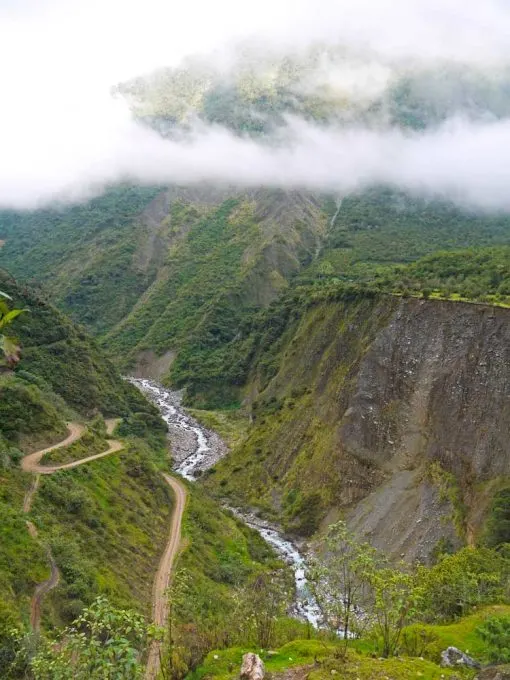
Day 5. Aguas Calientes – Machu Picchu – Aguas Calientes, 15km
Very early wake up, 4.30-5am you should leave your hostel to start up to Machu Picchu. You have two options; to take a bus all the way up or to walk. The walk from the town to the ruins takes about 1,5 hours, with steep 400m ascend. If you decide to walk, like us, take enough water. Don’t forget your torch, passport, and tickets. Entrance to MP opens at 6.00 if you are fast enough you’ll be there right in time.
Taking a bus from Aguas Calientes to Machu Picchu is another option, you can buy a ticket in the town. The ticket office is opened from 5 am to 9 pm, one-way ticket – US$12 (adults), return US$24. The journey to the top takes 40 minutes. Buses leave every 10 minutes; to MP from 5.30am till 3.30pm.; from MP from 6.00am till 6.00pm. You can walk up and take a bus down (there is a ticket office at the ruins) or other way around.
Need to know about visiting Machu Picchu
Don’t forget to buy a ticket to Machu Picchu beforehand you can’t buy it at the entrance. Only 2500 people in the morning, from 6 am to 12 pm and 3000 people in the afternoon, from 12 am to 5.30pm a day are allowed at the ruins. In high season make sure to book it at least a couple of days in advance.
Take your tickets and passport/ID with you have to show both at the entrance.
Huayna Picchu mountain visitors restrictions; entrance from 7 am to 8 am – 200 people; from 10 am to 11 am – 200 people.
Machu Picchu mountain; entrance from 7am to 8am – 400 people; from 9am to 10am – 400 people. It’s important to buy your Machu Picchu + Huayna Picchu/Machu Picchu ticket beforehand, especially in the peak season.
Make sure to enter the ruins and mountains at the time indicated in your tickets if you miss it you won’t be allowed to enter any other time.
New Machu Picchu rules were implemented in 2017 according to them all visitors supposed to have a guide to enter the ruins, in fact, nobody at the entrance enforces this rule there are people with and without guides. If you want to join a group you can do it; price US$20 per person or US$60 for a private guide per group.
Visitors are not supposed to bring food and water with which is quite strange as there are very few places where you can buy both. We’ve been to the ruins twice both times carrying day packs with water, sandwiches, snacks, and nobody has ever searched our bags or tried to stop us. This rule is mainly to protect the ruins from pollution as some people just damp plastic bottles and wraps. A reusable water bottle will be a better option and nobody will object to it.
Walking sticks are not allowed at the ruins we did hear about people being stopped and asked to leave them at the entrance so if your sticks are any value for you rather don’t take them. If your knees are a problem – take a bus down to Aguas Calientes.
Accommodation in Aguas Calientes
- Budget | H.Falcon | Supertramp Hostel Machupicchu | Ecopackers Machupicchu Hostel |
- Middle price | Retama Machupicchu | Qhaqya | Picos House |
- Luxury | Jaya Suite Machupicchu | Sumaq Machu Picchu Hotel | Inkaterra Machu Picchu Pueblo Hotel |
Getting from Machu Picchu to Cusco
There are four options;
To catch a train all the way from Aguas Calientes to Cusco – the easiest and the most expensive option; train ticket 277 Sol/US$85 price of the cheapest train ride Expedition 34. You have to buy tickets for this train a couple of weeks beforehand they are often sold out.
To go by train from Aguas Calientes to Ollantaytambo and from there take a bus to Cusco – it’s a bit cheaper than the first option but more complicated; train ticket – from 180 Sol/US$55 (the cheapest train leaves Aguas Calientes at 5.35am), bus ticket 15 Sol/US$4. A good thing about this option if you have time you can stay in Ollantaytambo and visit the ruins.
To get on a train from Aguas Calientes to Hidroeléctrica and from there take a minibus to Cusco – more complicated but cheaper; train ticket – 60 Sol/US$19, minibus ticket – 60 Sol/US$18.
To walk from Aguas Calientes to Hidroeléctrica, about 10km and from there take a bus to Cusco – the cheapest but the longest option; bus ticket 60 Sol/US$18.
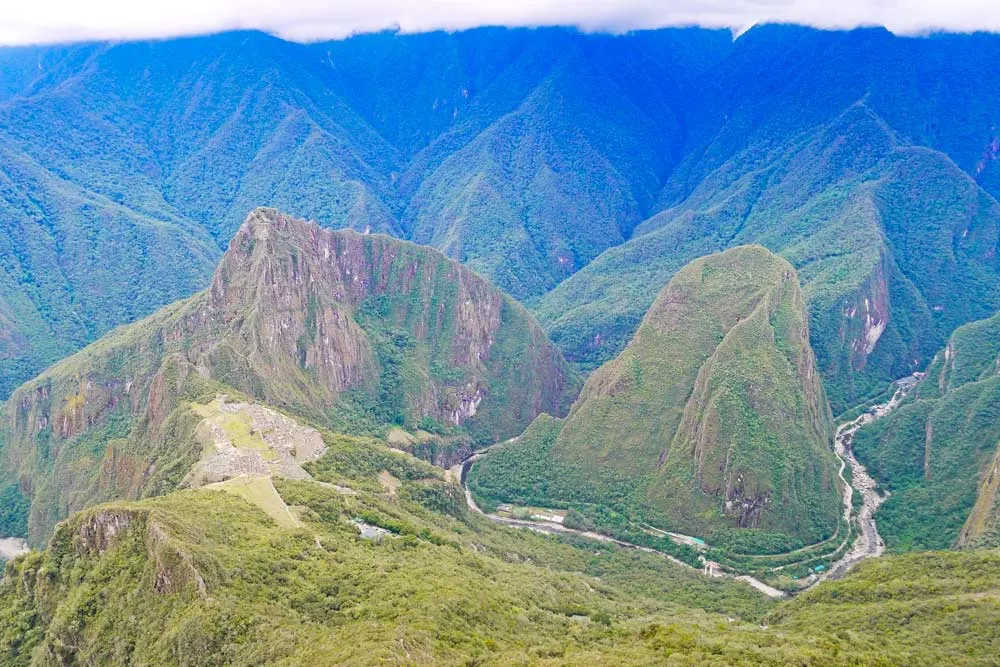
Recommended books and guidebooks
If you prefer e-books over paper books don’t hesitate to join Amazon Kindle Unlimited to get access to thousands of e-books and audiobooks. Even if you don’t have a Kindle device you can read or listen to books on your phone or tablet using the app. The first 30 days of the program are free.
- The Machu Picchu Guidebook: A Self-Guided Tour by Alfredo Valencia Zigarra. Paperback
- Lonely Planet Peru (Country Guide), 2019. Paperback and Kindle
- Lost City of the Incas by Hiram Bingham. Kindle & paperback
- The Last Days of the Incas by Kim MacQuarrie. Kindle, paperback & audiobook
- The Conquest of the Incas by John Hemming. Kindle &paperback
- Turn Right at Machu Picchu; Rediscovering the Lost City One Step at A time by Mark Adams. Kindle & paperback
- Death in the Andes by Mario Vargas Llosa. Kindle & paperback
Like this post? Pin it!
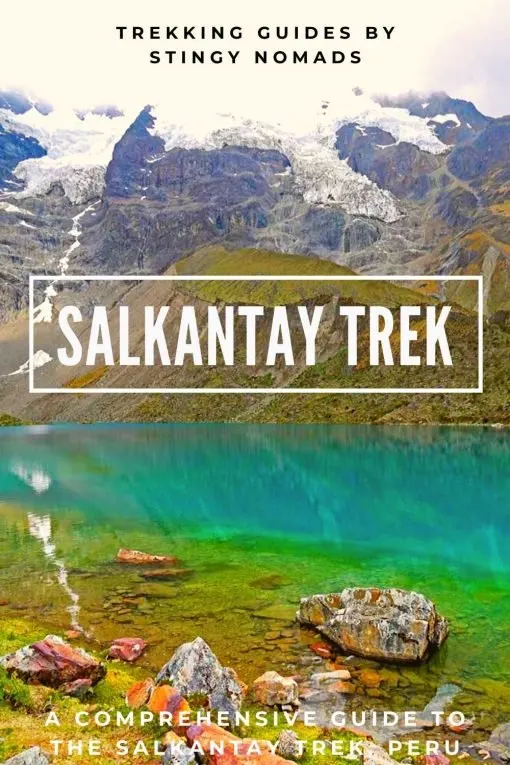
Disclosure: Stingy Nomads take part in the Amazon Services LLC Associates Program. We earn advertising fees by advertising and linking to Amazon.com. If you click on the link and purchase the item, we will receive an affiliate commission at no extra cost for you. Thank You!
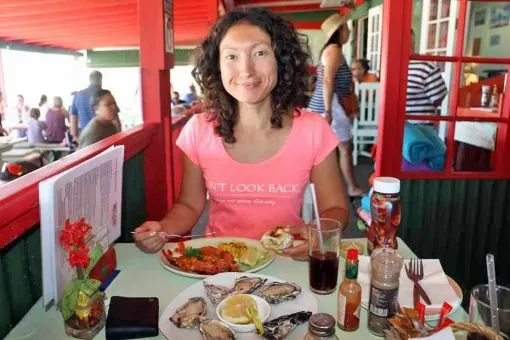
The pretty half of Stingy Nomads, responsible for all our land adventures (hiking, climbing, walking the Camino) and following them write-ups. Alya loves walking since she was a child, she prefers to walk 1000 km with a backpack rather than to do a 10 000 km road trip (actually any road trip). Alya is a big fan of Latin America, the Spanish language, and dancing. Every time we go away she desperately misses our dog Chile.





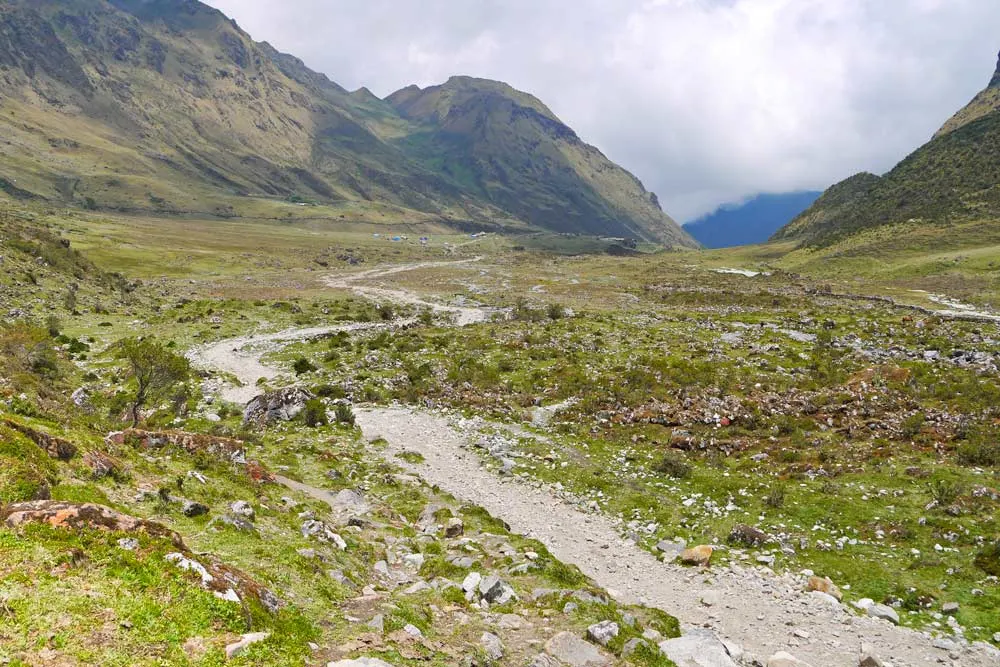
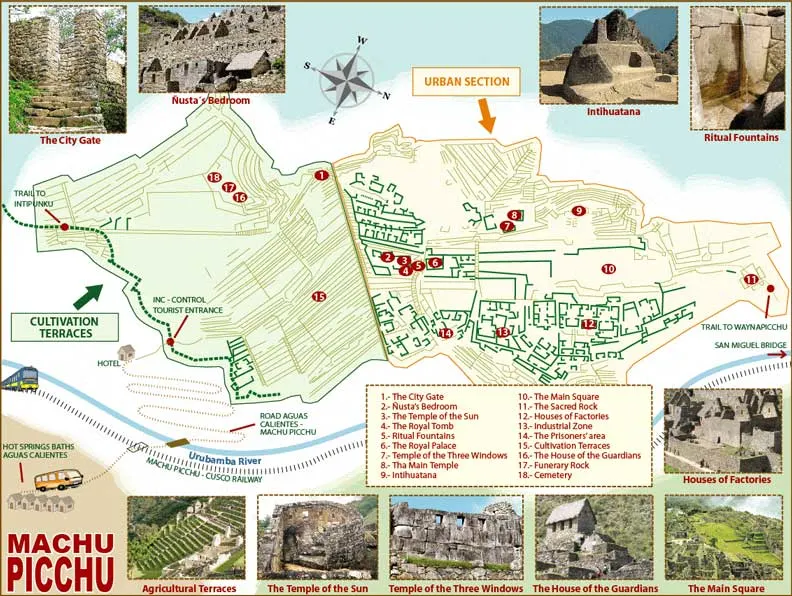
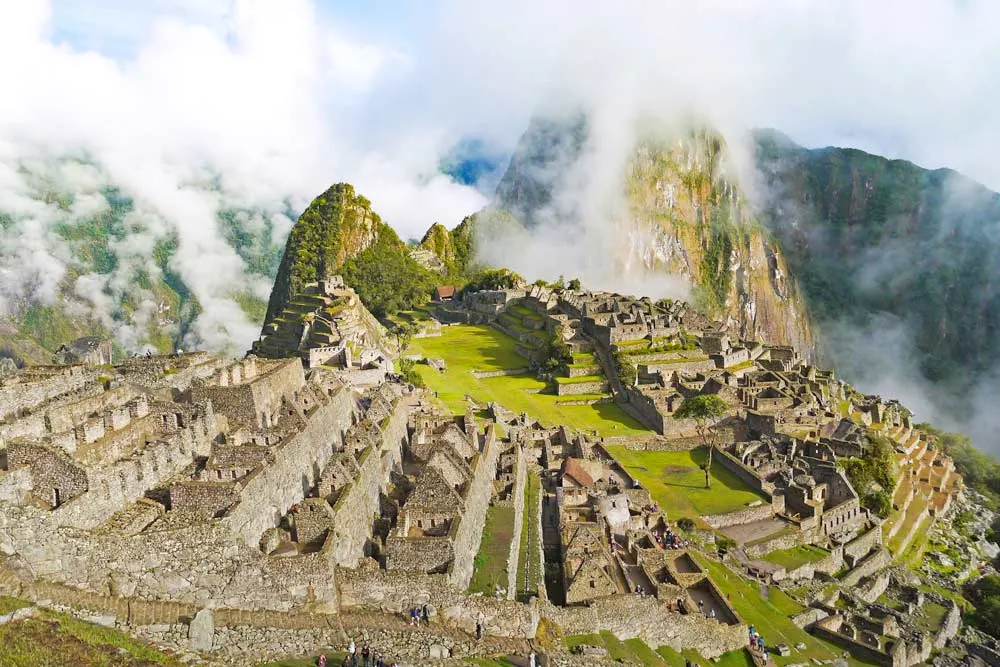
Sean
Tuesday 2nd of April 2024
Hi Stingy Nomads. We are looking at doing the Salkantay in September 2024. We want to do it independently but some people are saying it's too difficult now as the hostels are taken by the tour groups and no one is staying in tents any more. I think you wrote this super helpful guide pre 2019. Do you have any recent info to guide me on this? Thanks!
Sean
Tuesday 9th of April 2024
@Stingy Nomads, ok, thanks.
Stingy Nomads
Friday 5th of April 2024
Hello Sean. Thank you for the comment. We haven't been to Peru in the last years. Sorry, we don't have any update on the situation on the Salkantay trek. Good luck
John
Monday 25th of April 2022
Hey, thank you for this detailed guide. One question I had was if there were any points where campfires were permitted? Thank you!
Stingy Nomads
Monday 25th of April 2022
Hello, John. Thank you for the comment. We used a camping stove for cooking. Some campsites might have designated places for making fires but I don't think you can make a campfire in the wild. Cheers
TRENT
Sunday 16th of January 2022
I am interested in The 5 day Salkantay trek in early MAY. I hike with a peruvian friend, and my small, athletic dog. Are dogs allowed on the Salkantay trail? My friend can watch my dog as I enter M.P. park. We are open to any alternative routes and your suggestions. Please help w information ok. Thanks, TRENT
Stingy Nomads
Monday 17th of January 2022
Hello, Trent. We didn't see any hikers walking with a dog on the Salkantay trek. I can't recall any signs that dogs are not allowed on the trek itself but they're not allowed at Machu Picchu so your friend can stay in Aguas Calientes with your dog while you go to the ruins. If you want to see MP the Salkantay trek is probably your best option. It gets quite cold up in the mountains especially at night pack some blankets for your dog. Cheers
Sandra
Thursday 7th of October 2021
My fiance and I are wanting to do a combined Salkantay and Inca trek for our honeymoon in March. I want to go with a guided tour but there are so many to choose from, any recommendations?
Stingy Nomads
Tuesday 12th of October 2021
Hello, Sandra. We can recommend G-Adventures, it's a well-known international company with a good reputation and many reviews. They're more expensive than small local companies but they're reliable. The Inca Trail is quite an expensive tour you want to make sure you're getting good service for that kind of money. We haven't done the Inca Trail and the rest of the hikes in the Sacred Valley we did independently so we can't recommend any local companies. If G-Adventures works out too expensive you can shop around once in Cusco. Around the main square Plaza de Armas there are several tour agencies. Good luck
Kirstine Timmermann
Friday 6th of March 2020
Hi! My friend and I are thinking about doing the trek without a guide, but wondering about the food. How often do you cook yourself, and how often could you buy a meal somewhere?
Stingy Nomads
Thursday 12th of March 2020
Hello, Kristine! We carried food and cooking stuff but from what I remember from day 2 (after the pass) on there were local places where we could buy food. I think on the first day as well there is a hotel/restaurant 1 or 2km before the campsite I think it's a bit pricey though. Cheers!